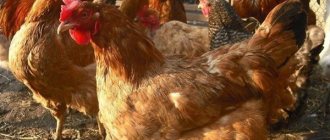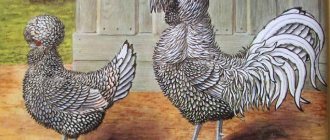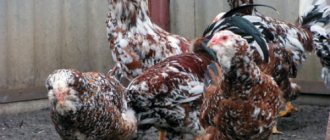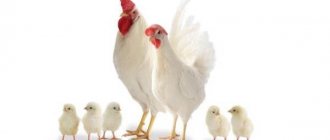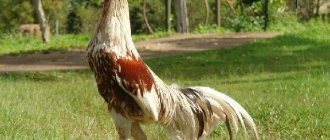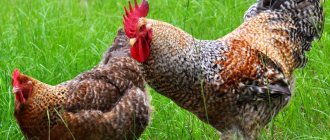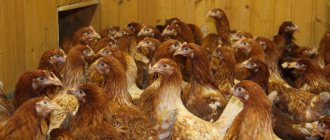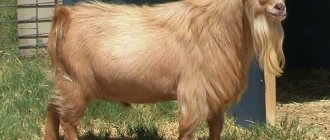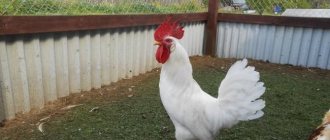The Legbar chicken breed is quite rare. Breeding scientists Michael Pease and Reginald Punnett from the Genetic Institute of the University of Cambridge in the 30s were engaged in breeding a breed of chickens with autosex properties (the ability to determine the sex of chickens by the color of their down at one day of age), but at the same time so that the chickens were distinguished by high egg production.
Golden Legbar chickens were a cross between Leghorns and Striped Plymouth Rocks, and were standardized in 1945. The resulting Golden Legbar was crossed with a White Leghorn and a Golden Kempinian cock to produce the Silver Legbar in 1951. Next, he was crossed with a white Leghorn and an Araucan. Result: cream legbar, which was presented at the agricultural exhibition in 1958. The new breed of chickens laid blue eggs. For some time the breed was not in demand and almost disappeared. About the Legbar chicken breed, watch the video:
History of chicken breeding
Legbar chickens were bred in Cambridge. Breeders Punnett and Pease worked on the creation of the breed. Scientists tried to produce chickens that are characterized by autosex and high egg production, but the result of their work was birds that can also be raised for meat. First, representatives of the following breeds were involved:
- Partridge Leghorn.
- Plymouth Rock.
- Kempinskaya.
The resulting chickens from this crossing had a characteristic cuckoo coloration, but were characterized by low productivity.
To improve the result, the genetic material of white leghorns and aracoons was used. From the latter, legbars inherited the ability to lay blue-shelled eggs. Work on creating the breed lasted almost 15 years and ended around the middle of the 20th century. The standard was registered in 1945.
As a result, birds with silver, golden and cream cuckoo-pied plumage were bred. Their popularity among breeders turned out to be uneven. Crested chickens with silver plumage are not now found; the beige variety is most in demand.
Description of the Legbar breed
Legbars look unusual. They have a distinctive feathery crest on their heads. However, this is not the only sign by which one can determine whether a bird belongs to this breed.
Legbar chickens are distinguished by their beautiful appearance, peaceful character, and high egg production.
Appearance Standards
The birds have beige feathers with brown stripes. Roosters are slightly lighter in color than hens, but their stripes are more pronounced. The birds' skin is yellowish.
Males have a wedge-shaped body, while females have a rounded body. The head is small, but proportionate. The eyes are big. The beak is strong, with a curved tip, rich yellow. There is a large crest of feathers on the head. It is larger in females than in males. The difference between them can be seen in the photo below.
Roosters have a large red comb. It consists of 6 teeth and stands straight even at rest. In chickens, the comb is smaller and thinner, falls slightly to one side, but does not cover the eyes. The earrings are medium size and round in shape. The earlobes are oval, white, well developed. The neck is long and densely covered with feathers. The chest is round in shape. The back is long, but not wide. The tail is small.
The wings are not voluminous, fitting tightly to the body. The braids are wide and long. Paws are of medium length, toes set wide. Judging by the description, Legbar chickens are characterized by pronounced autosex: the sex of the young can be determined immediately after hatching.
Cockerels have light beige down with diffuse dark spots. The chickens are dark brown in color with longitudinal stripes on the back.
Bird temperament
Legbars are active and curious. They are active and love to go for walks. Birds require a pen, because when free-ranging, they often dig up plants and dig holes in flower beds. They are required to protect green spaces. Laying hens are not aggressive. They get along well with each other and rarely conflict with other birds. Maternal instinct is weakly expressed. Even if hens lay eggs, they can rarely wait until the chicks hatch.
Legbar chickens have a calm character.
Males have a violent character. If several roosters live in the same territory, they will fight often. There are frequent cases of them attacking other birds living in the chicken coop. To reduce aggressiveness, breeders use green lighting: it is believed that it has a calming effect on males.
In addition, in order to tame the violent temperament of legbars, red-painted feeders are placed in the aviary and in the chicken coop. If this does not help, males must be kept in a separate room to avoid injury.
Productivity table
For ease of perception, information about the productivity of the breed is presented in the form of a table.
| Productive qualities | Indicators |
| Meat productivity | The weight of adult chickens reaches 2.7-3 kg. The weight of roosters averages 3.5 kg. Birds reach these parameters in six months. |
| Egg production | On average, a laying hen produces about 220 eggs per year. However, if quality care is provided, this figure can be increased to 270 pcs. The egg weighs 75 g. |
| Maturation | Laying hens begin to lay their first eggs at 4-6 months. At first they are small. Full maturation of chickens occurs at the end of the first year of life. |
About reviews
Before getting a particular breed of chicken, the future breeder reads about it in books and on the Internet. He is interested in the advantages and disadvantages.
Reviews about the advantages of Legbars are as follows:
- Egg production is above average. The eggs are blue or olive in color, which allows them to be sold on the market at a higher price than ordinary white or light brown ones.
- Legbar birds are calm. They do not fight with other individuals in the chicken coop.
- Legbars have excellent immunity, which makes it possible to successfully resist various viruses.
- From the 1st day of life, females can be easily distinguished from males by the brown stripe on the head and back.
If the breeder of Legbar chickens is inexperienced, then having learned from this article about the differences between females and cockerels, he will be able to clearly say in just one day how many hens have hatched and how many males.
Characteristics of the breed's shortcomings are as follows:
- In the cold season, if the chicken coop is not heated enough, the hens will lay eggs less, and in cold weather they will not produce eggs at all. Birds are sensitive to low temperatures.
- Chickens have a poorly developed maternal instinct. Therefore, chicks are raised in incubators.
Advantages and disadvantages of legbar chickens
Legbars have a number of disadvantages and advantages that must be taken into account by those who want to own such birds.
Positive qualities include:
- calm nature of laying hens;
- rare cases of eggs pecking;
- eggs with blue shell color;
- good health;
- pronounced autosex.
Legbar chickens produce beautiful blue-shelled eggs and boast tasty and juicy meat.
The disadvantages of these birds include their high sensitivity to ambient temperature. When the indicators drop to a level below the comfortable level, egg production in laying hens decreases. Often the laying stops. Thus, keeping this breed in Russian conditions requires additional costs for heating the premises. Some breeders consider the lack of maternal instinct to be a disadvantage. Eggs have to be placed in the nests of other birds or in a special incubator.
Features of care and maintenance
Legbars are demanding in terms of living conditions. For a normal life, they require an insulated poultry house, protected from drafts. Perches made of timber with rounded edges are installed inside the room. They are placed at a height of 1 m from the floor. Nests for laying eggs are made 40x40 cm in size. The recommended height is 80 cm. Hay is placed at the bottom. The litter should be changed periodically.
These chickens do not tolerate cold well and often die because they cannot survive severe frosts. In winter, additional heating of the chicken coop is required. High humidity negatively affects the productivity of birds. It is necessary to regularly clean the chicken coop and replace the litter. Good ventilation should also be ensured.
Representatives of the breed do not like cramped conditions, so they are not suitable for cage keeping. There should be at least 0.5 m of chicken coop area per individual. In addition, legbars should not be housed with other species of birds.
It is believed that loud noises coming from geese and ducks can cause a decrease in the productivity of laying hens.
In cold weather, these chickens are not allowed out of a warm room, but in the summer they require long daily walks, so they should be equipped with a spacious pen. It should have a roof on top so that the chickens are protected from the scorching sun and rain. It is advisable to arrange the enclosure so that wild birds cannot get into it. This will protect the chickens from infection and parasites.
Legbar chickens are easy to care for and have a friendly disposition.
Legbars are prone to obesity. An increase in the thickness of the fat layer negatively affects the quality and quantity of eggs. You need to choose the right diet for chickens, and also regularly give them vitamin and mineral supplements. Legbars have good immunity, but if there is a lack of nutrients, their toes become crooked.
Lighting and temperature parameters in the enclosure
Legbar is a heat-loving breed. In winter, the temperature in the chicken coop should be at least +15…+18 °C. To monitor it, it is recommended to hang a thermometer in the room. The floor is insulated with sawdust, hay or peat. In this case, the flooring should be changed regularly to prevent increased humidity.
To maintain egg production, you need to provide chickens with up to 13-14 hours of daylight. To do this, lamps are mounted on the ceiling. The backlight is turned on in the morning and evening. You can set a timer that will automatically turn the lights on and off.
Feeding ration
To avoid obesity in laying hens, you should not give them granular mixtures often. Such feed can be introduced into the diet of birds no more than 2 times a week.
Chickens should be given:
- oats;
- wheat;
- barley;
- ground corn;
- cake;
- roots;
- meat and bone and fish meal.
Legbars can become obese if overfed.
To support legbar egg production, calcium supplements are added to their diet. Its sources are limestone, shell rock, chalk, etc. In the summer, birds are regularly given chopped grass, vegetables and fruits, and porridge is made from grain. It is necessary to ensure that the remains of wet mixtures do not remain in the feeders. They can multiply pathogenic microorganisms that can cause intestinal upset in birds. Laying hens must have access to water.
Care during shedding
Legbars molt in winter. The process takes up to 2 weeks. During this period, laying hens stop producing eggs. To maintain the health of birds, they need to be given vitamin complexes. Containers with ash and sand should be placed indoors so that chickens can bathe in them. Long daylight hours can delay shedding. In this case, you need to contact a veterinarian who will help induce it artificially.
Breeding
Due to the underdeveloped brooding instinct, an incubator is the preferred breeding option. Medium-sized eggs without damage to the shell are suitable for incubation. During this period, you need to regularly turn the eggs and monitor the temperature and humidity.
Chickens are resilient . At one day of age, they have a sexual difference: future roosters have lighter down, and a dark spot on the head. Babies should be fed corn grits, gradually adding grass, bone meal and fertilizer.
IMPORTANT : Cream Legbars are calm birds with a peaceful character. As the chicks grow, it is important not to frighten or tease them (they may become aggressive). Laying hens have high egg laying rates, and all representatives of the breed have good immunity.
Reproduction of the Legbar breed
Legbars can be bred at home if there is breeding stock. The flock must have at least 1 unrelated rooster per 10 hens. In this case, almost all eggs will be fertilized. It is better to take eggs from chickens that have already reached sexual maturity.
They should be taken from their nests at 7-8 o'clock in the morning. The fresher they are, the better. They are then examined with an ovoscope to identify defects that could become an obstacle to the development of the embryo. Eggs should be stored with the blunt end facing up. They need to be turned over periodically to avoid the yolk sticking to the shell. Before placing them in an incubator or under a brood hen, it is recommended to store eggs for no more than 3 days at a temperature of no more than +18 °C.
Hatching or incubator
Legbars lack maternal instinct, so they are reluctant to sit on the clutch. Their eggs can be placed under the hens of other breeds of chickens, geese and ducks. However, it is better to use an incubator to produce chicks. Hatchability reaches 90%. When using hens, the percentage is lower.
The chicken needs to lay a small number of eggs, otherwise she will not hatch them.
Conditions for keeping chickens
Once hatching has begun, the hatchlings should not be immediately removed from the incubator. They should be left in the apparatus for several hours so that they dry out and do not catch a cold during transplantation. After this, they are placed in brooders or cardboard boxes with soft bedding.
After 6-8 hours you can feed the chicks for the first time. They are given a mixture of cottage cheese and greens. To teach chickens to eat, they need to pour food on their backs - they will start pecking at it. In addition, you can give them curdled milk.
Then you need to gradually introduce crushed boiled eggs, mash and grain into the diet. Young animals should not be overfed, as this will slow down their growth. It is necessary to regularly change the litter in the brooder. For the first 2-3 days, chicks require round-the-clock lighting. They are then transferred to a 14-hour day of light.
Productivity
Legbar is popular not only because the hens produce blue eggs (although its fame is largely due to this), but also because it is a fairly productive egg bird. Legbars have Leghorn blood, which is what caused such high egg production rates. On average, one hen produces about 250 eggs per year.
At home, without quality care and the availability of special feed, you can expect 200-210 eggs per year from a chicken. The egg has a round shape and an average weight of about 60 g.

